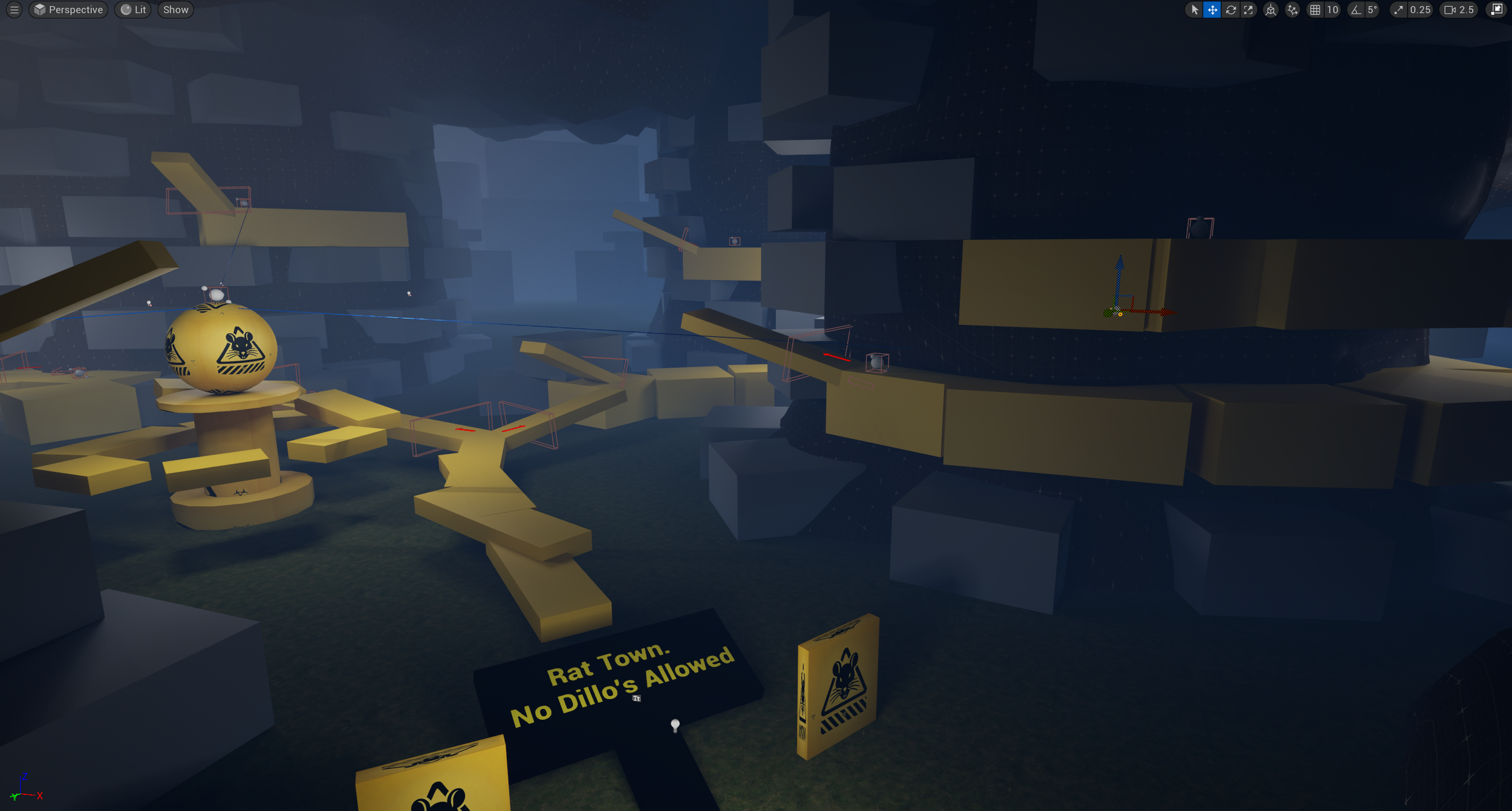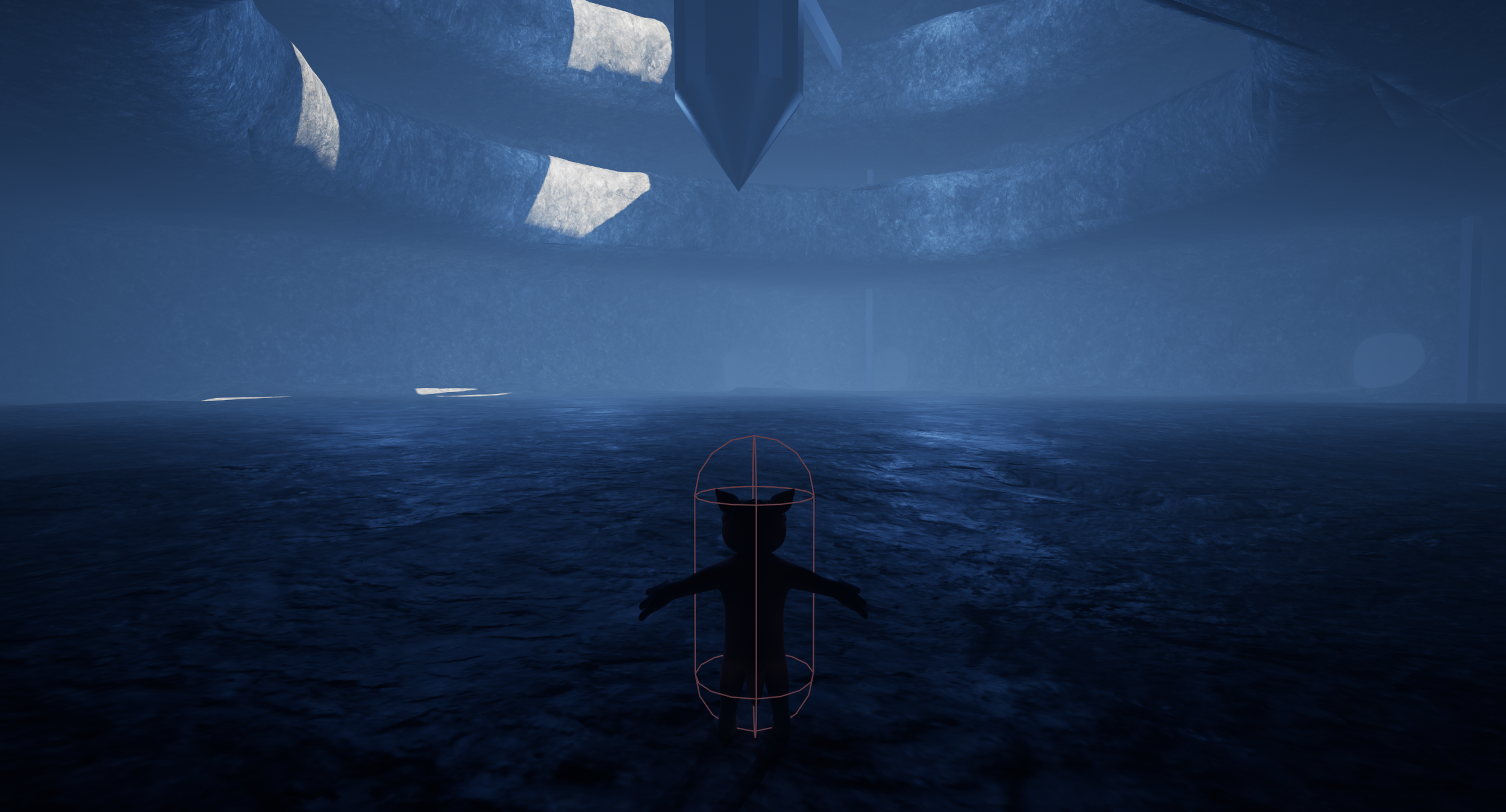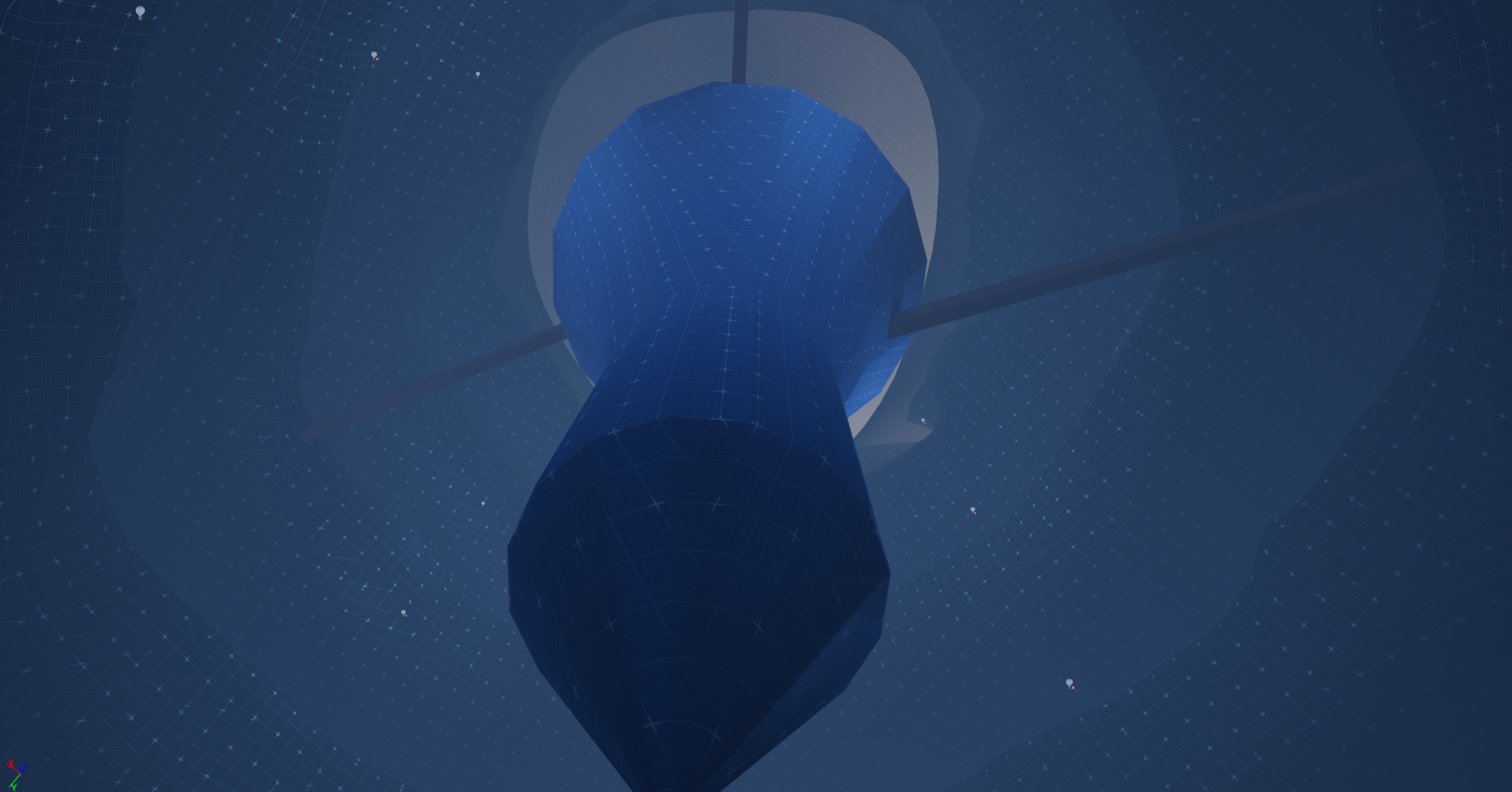Dillo’s Dilemma
Responsibilities:
Designed the level layout, quest list, and visual launguage of the second level of Dillo’s Dilemma.
Scripted player interactions and quest objectives including the bell system and rat king statue challenges
Set Dressed the entire level
Animated the cinematic sequencers present in the level
Lit the level in conjunction with a lighting artist creating initial proxy lighting, and doing final lighting touches using the lighting artists set standards
Implemented assets created by other team members into the level such as rat spawners that chase the player, breakable walls and boxes, and the fort system
Details:
Team Size: 18
Genre: 3D Platformer RPG
Role: Lead Level Designer (3 Level Designer Team)
Engine: Unreal Engine 5.4
Tools Used: Sequencer, Chaos, Modeling Tools
Early Blockout
Beat 1: Sewer Entrance
The level begins with Dillo emerging from a sewer grate into the outer edge of the Rat Kingdom. Blinkos—mechanical traversal tools modeled after pinball parts—are used to travers the level and were tutorialized in the first level of this game. This is the beginning of level 2. The goal is to discover the location of the resistance base against the Rat King.
First Optional Statue Challenge:
Requires players to hit the statue by chaining momentum from a backwards bumper into a spring
Built to teach adaptation over precision—players are expected to miss, then adjust using double jump and timing.
Chaining Spring Blinkos Tutorial:
Introduces multi-step platforming early to build player confidence before more complicated platforming challenges come later.
Increases complexity from earlier levels that relied on single-spring solutions.
Fireflies were placed on top of the gate to highlight the goal.
Opening Sequence:
The trigger box checks for the player on tick using an actor array, then destroys itself to reduce runtime cost.
This logic is kept out of the Level Blueprint to prevent it replaying when the player goes back and forth between levels.
The sequence is framed to establish vertical scale and orient the player before control begins.
Mandatory Rat King Statue Challenge:
Gates progression behind a required statue break to teach the side-objective system.
Uses Chaos fracture with OnBreak triggering a sequencer that spawns a reward firefly jar and opens the nearby gate.
Invisible barriers block unintended paths from below the statue, forcing the intended rooftop approach.
Beat 2: Resistance Base
As Dillo explores further, he reaches the resistance base. This base is hidden within the city and protected by loyal rebels against the Rat King. They reveal the objective: activate three massive bells scattered across the kingdom which are used to tell the guards to open or close the mine gates. Captured allies are being held within the mines. Before going off to chase the bells, they instruct Dillo to climb the tower above their camp and retrieve the Super-Blinko Puncher, a high-powered upgrade that doubles the power of a regular puncher. This item is required to break down the impassible gate the player passed earlier.
Super-Blinko Pickup Sequence
Built using Sequencer with multiple camera cuts, camera shake, and timed transitions.
Features a dialogue moment with the Resistance leader, establishing the mission to activate three bells scattered across the city.
Pans to the first bell, showing it can be accessed directly from the base—framing it as a natural next step after the cutscene ends.
Resistance Cutscene:
Built in Sequencer with a dialogue manager to establish the Resistance's current state following a Rat King raid, framing the base as scattered but still active.
Concludes with a tilt up to the Super-Blinko resting atop the tower, visually establishing the player's next objective before control resumes.
Super-Blinko Acquisition:
This challenge requires the player to utilize several combinations of movement mechanics and is more difficult than it may appear. The platforms are large when still, but can easily be jumped over without precise movement.
Designed to make the Super-Blinko feel earned, while also providing a high vantage point that offers a full view of the Rat Kingdom below.
Beat 3: Full City Exploration & Bell Locations
The Rat Kingdom is a single region divided into two meaningful subzones: the first area included the sewer entrance and resistance base. In Beat 3 the world opens up a lot more with the market and overgrown areas and mission objectives can be completed in any order. We needed the player to acquire the super blinko so the beginning of this level worked as a linear experience leading up to that event, but once that was acquired the level opens up allowing the player to choose how they finish the rest of the objectives.
Mission Objectives for the second half of the level include:
Ringing all three bells around town to open the mines allowing access to a new level for the player to experience
Collecting fireflies around town and destroying all of the optional Rat King Statues which award 5 fireflies to purchase other upgraded blinkos from the shop
Completing the optional fort in the market
2nd Bell Challenge:
Uses four spring Blinkos placed at varying heights to encourage lateral and vertical exploration around the tower.
Designed without a fixed solution—players must experiment to find a viable path upward.
Bell chamber includes four window vistas that subtly reveal Rat King statue locations and traversal routes.
2nd Mandatory Rat King Statue Challenge:
Gates fully enclose the statue, prompting players to seek alternate routes and rethink the space vertically.
A puncher and two springs form a traversal chain that guides the player upward and over the barrier.
Breaking the statue unlocks a gate to a key ramp for Bell 3, reinforcing its role in core progression.
3rd Optional Rat King Statue Challenge:
Functions as a long jump challenge requiring solid momentum and timing to reach the statue.
Designed to let players test their mastery of single-jump distance after gaining confidence throughout the level.
Feels rewarding to clear—no trick, just execution.
Super-Blinko Wall:
The breakable wall is shown early, but blocks progress without enough speed—triggering a UI hint when hit too softly.
An invisible wall exists which is lowered after the player acquires the super-puncher preventing edge-case skips discovered during testing.
This wall is removed upon collecting the Super-Blinko, preserving the physics-based solution while gating it behind the upgrade.
1st Bell Challenge:
Requires using a Blinko station to grab a bumper or puncher, then chaining into a spring to launch Dillo across a long gap to the bell tower.
Hitting the bell triggers a stylized Wwise sound cue, starts a rocking animation via timeline, and displays the bell UI (x/3 hit).
Also increments a hidden integer on the mine door Blueprint, which opens the next level once it reaches 3.
Environmental Physics Props:
Converted static props to physics-based interactables in response to feedback that the world felt too rigid.
Prioritized high-traffic areas like the market to maximize player-facing impact.
Reinforces the weight of Dillo’s movement and power behind his actions in the world
2nd Optional Rat King Statue Challenge:
Statue is placed in a dense, inaccessible area to create initial confusion and prompt exploration.
Graffiti-marked rooftops visible from Bell 2 hint at the intended path without explicit direction.
Chained springs and rooftop traversal guide the player above the statue for a drop-down destruction.
Bell 3 Challenge:
Requires reaching both sides of the tower via two separate ramps—one unlocked through a statue puzzle, the other discovered through market exploration.
Each side is boarded up; hitting one triggers a Sequencer that collapses the opposite board, subverting player expectations.
Sequencer destruction on repeat visits prevents redundancy and keeps pacing tight during re-approach.
Full Level Playthrough
First Draft Gameplay Prototypes
Initially there were many different ideas for what the game would look like. We knew generally as a team that it would have pinball mechanics and be RPG-like with story and worldbuilding. These early prototypes were used to test movement, what the world might feel like, and what types of tools might be interesting or useful. This is where we discovered how we could make the gameplay fun and what type of movement was enjoyable. We then used those discoveries to scale back the scope, trim the fat, and focused on creating the game using the most fun parts of what we had discovered.





























